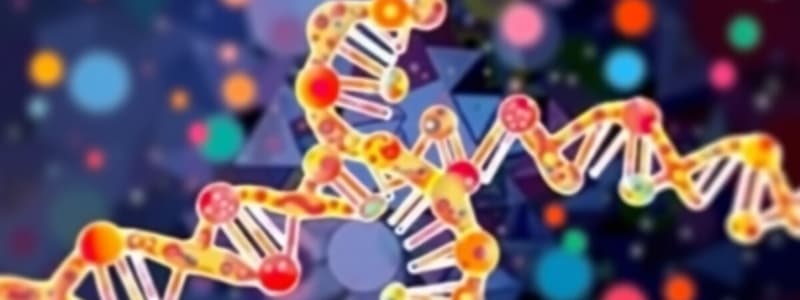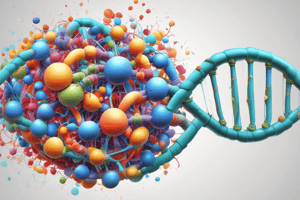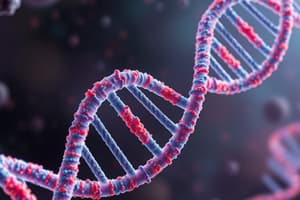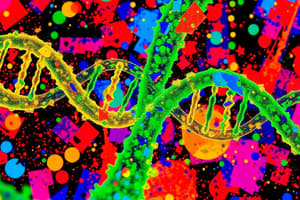Podcast
Questions and Answers
What is the primary role of the single stranded binding protein during the initiation step of DNA replication?
What is the primary role of the single stranded binding protein during the initiation step of DNA replication?
- To recognize termination sequences
- To add nucleotides to the growing DNA strand
- To prevent reannealing of separated strands (correct)
- To synthesize RNA primers
Which statement accurately describes the synthesis of the lagging strand during DNA replication?
Which statement accurately describes the synthesis of the lagging strand during DNA replication?
- It consists of short segments known as Okazaki fragments. (correct)
- It proceeds continuously from the replication fork.
- It is synthesized in continuous fragments.
- It requires no RNA primers for initiation.
How does DNA polymerase III differ in its activity on leading and lagging strands?
How does DNA polymerase III differ in its activity on leading and lagging strands?
- It uses separate core subunits for leading and lagging strands. (correct)
- It synthesizes lagging strands continuously.
- It adds nucleotides in the 3'-5' direction for the leading strand.
- It uses a single core subunit for both strands.
What is the final step involved in completing the lagging strand synthesis?
What is the final step involved in completing the lagging strand synthesis?
What initiates the synthesis of new Okazaki fragments on the lagging strand?
What initiates the synthesis of new Okazaki fragments on the lagging strand?
During which phase of the cell cycle does eukaryotic DNA replication primarily occur?
During which phase of the cell cycle does eukaryotic DNA replication primarily occur?
Which of the following statements about prokaryotic replication is true?
Which of the following statements about prokaryotic replication is true?
What distinguishes eukaryotic DNA replication from prokaryotic DNA replication?
What distinguishes eukaryotic DNA replication from prokaryotic DNA replication?
Which of the following enzymes is involved in eukaryotic DNA replication?
Which of the following enzymes is involved in eukaryotic DNA replication?
How does the structure of eukaryotic DNA differ from prokaryotic DNA?
How does the structure of eukaryotic DNA differ from prokaryotic DNA?
What is the primary function of the PCNA sliding clamp in DNA replication?
What is the primary function of the PCNA sliding clamp in DNA replication?
During which phase of the cell cycle does DNA replication occur?
During which phase of the cell cycle does DNA replication occur?
Which polymerase is associated with leading strand synthesis?
Which polymerase is associated with leading strand synthesis?
Which enzyme is required for relieving torsional strain ahead of the replication fork?
Which enzyme is required for relieving torsional strain ahead of the replication fork?
How many base pairs are synthesized in nucleotides per second during rapid DNA replication?
How many base pairs are synthesized in nucleotides per second during rapid DNA replication?
What are small DNA fragments produced on the lagging strand called?
What are small DNA fragments produced on the lagging strand called?
What is the significance of the semiconservative model of DNA replication?
What is the significance of the semiconservative model of DNA replication?
Which statement is true about the direction of DNA synthesis?
Which statement is true about the direction of DNA synthesis?
Which pair of DNA polymerases are primarily involved in elongating the DNA strands?
Which pair of DNA polymerases are primarily involved in elongating the DNA strands?
What is required for the assembly of the helicase and primase complexes during DNA replication?
What is required for the assembly of the helicase and primase complexes during DNA replication?
Prokaryotic cells contain multiple chromosomes and are classified as diploid cells.
Prokaryotic cells contain multiple chromosomes and are classified as diploid cells.
Plasmids in prokaryotic cells contain essential genes that are necessary for survival.
Plasmids in prokaryotic cells contain essential genes that are necessary for survival.
The shape of prokaryotic DNA is linear, as opposed to the circular shape observed in eukaryotic DNA.
The shape of prokaryotic DNA is linear, as opposed to the circular shape observed in eukaryotic DNA.
The origin of replication in E. coli is known as OriC, consisting of 245 base pairs.
The origin of replication in E. coli is known as OriC, consisting of 245 base pairs.
The initiation step of DNA replication in prokaryotes occurs in the nucleus.
The initiation step of DNA replication in prokaryotes occurs in the nucleus.
The synthesis of the lagging strand proceeds continuously along the replication fork.
The synthesis of the lagging strand proceeds continuously along the replication fork.
DNA polymerase I is responsible for removing RNA primers and sealing gaps between Okazaki fragments.
DNA polymerase I is responsible for removing RNA primers and sealing gaps between Okazaki fragments.
Both leading and lagging strands are synthesized in the 3'-5' direction.
Both leading and lagging strands are synthesized in the 3'-5' direction.
The helicase and primase work together within a replication complex known as the primosome.
The helicase and primase work together within a replication complex known as the primosome.
Termination of DNA replication occurs when the two-replication forks meet at specific sequences.
Termination of DNA replication occurs when the two-replication forks meet at specific sequences.
Study Notes
Prokaryotic DNA Replication - Initiation
- Single-stranded binding protein (SSB) binds to the separated strands to prevent reannealing and stabilize them
- DNA polymerase cannot initiate replication on its own.
- DNA primase synthesizes RNA primers in the 5’-3’ direction.
Prokaryotic DNA Replication - Elongation
- Leading Strand Synthesis:
- RNA primer is synthesized by primase at the replication origin.
- DNA polymerase III adds nucleotides at the 3’ end.
- Synthesis proceeds continuously along the replication fork until termination sequences are encountered.
- Lagging Strand Synthesis:
- Synthesized in short fragments called Okazaki fragments.
- RNA primer is synthesized by primase, followed by DNA polymerase III adding nucleotides in the 5’-3’ direction.
- Helicase and primase form a functional unit called the primosome within the replication complex.
- DNA polymerase III uses one core subunit to synthesize the leading strand and another to synthesize the lagging strand.
- When Okazaki fragment synthesis completes, the core subunit dissociates from its sliding clamp and associates with a new one, initiating the synthesis of new Okazaki fragments.
Prokaryotic DNA Replication - Elongation (cont.)
- Both leading and lagging strands are synthesized in the 5’-3’ direction.
- Both strands can be replicated simultaneously by two subunits of DNA polymerase III moving in the same direction.
- Lagging strand synthesis isn't complete until the RNA primer is removed and gaps between adjacent Okazaki fragments are sealed.
- The RNA primer is removed by the 5’-3’ exonuclease activity of DNA polymerase I and replaced with DNA.
- The gap is sealed by DNA ligase using NAD+ as a cofactor.
Prokaryotic DNA Replication - Termination
- The two replication forks of the circular E. coli chromosome meet at termination sequences (ter).
Eukaryotic DNA Replication
- Eukaryotic replication is a complex process.
- It occurs only during the S phase of the cell cycle, with pre-initiation taking place during the G1 phase.
Eukaryotic DNA Replication - Differences from Prokaryotic Replication
- Multiple origins of replication are established on each chromosome.
- It is a discontinuous process during the S phase.
- Requires new enzymatic activities to deal with the ends of chromosomes.
- DNA replicates in the nucleus.
- The replication machinery is larger and more complex.
- The initiation phase requires additional factors to assemble helicase, primase, and polymerase complexes.
- The main replication polymerase is a complex of two enzymes working together: DNA polymerase epsilon (Pol ε) and DNA polymerase delta (Pol δ).
- The sliding clamp unit is called PCNA (proliferating cell nuclear antigen).
Features of Eukaryotic DNA Replication
- It is a bidirectional process and originates at multiple origins on each chromosome.
- It follows a semiconservative model, resulting in a double-stranded DNA with one parental strand and one new daughter strand.
- It occurs only in the S phase.
- It takes place in the cell nucleus.
- DNA synthesis occurs in the 5’-3’ direction.
- Lagging strands are created by the production of small DNA fragments called Okazaki fragments that are eventually joined together.
Eukaryotic DNA Polymerases
- DNA pol α (alpha): Involved in RNA primer synthesis and initiation of DNA synthesis.
- DNA pol δ (delta): Involved in lagging strand synthesis, repair, and proofreading.
- DNA pol ε (epsilon): Involved in leading strand synthesis, repair, and proofreading.
- DNA pol γ (gamma): Involved in mitochondrial DNA replication and repair.
- DNA pol β (beta): Involved in base-excision repair.
- DNA pol η (eta), ζ (zeta), κ (kappa): Involved in translesion DNA synthesis.
- DNA pol θ (theta), λ (lambda), μ (mu): Involved in DNA repair.
Enzymology of Eukaryotic DNA Replication
- Helicases: Unwind the DNA helix at the start of replication.
- SSB Proteins: Bind to single strands of unwound DNA to prevent reformation of the DNA helix during replication.
- DNA Polymerases:
- Eukaryotes contain several different DNA polymerases: α, β, γ, δ, and ε.
- DNA polymerase α carries a primase subunit and synthesizes RNA primers.
- DNA polymerase δ synthesizes the lagging strand via Okazaki fragments. It is the primary lagging strand replicase.
- DNA polymerase ε synthesizes the leading strand.
- DNA polymerase γ replicates mitochondrial DNA.
- DNA polymerase β is involved in base excision of DNA nucleotides.
- RNase H and FEN1:
- RNase H recognizes and removes RNA primers that are paired with the DNA strand.
- FEN1 cleaves the flap structures of nucleic acids and cuts the RNA flap structure left by RNase H, ensuring only DNA is left in the newly synthesized strand.
- DNA Ligase I:
- Seals nicks in double-stranded DNA during replication.
- Joins short Okazaki fragments and forms a 3’-5’ phosphodiester bond between adjacent fragments of DNA.
- DNA Topoisomerase:
- Topoisomerase I and II enzymes handle the relaxation of supercoils that form during replication.
- They cut and re-ligate the DNA to relieve tension.
- Topoisomerase I relaxes the DNA helix by creating a nick in one of the DNA strands.
- Topoisomerase II relieves strain on the DNA helix by creating nicks in both strands of DNA.
- Telomerases:
- A DNA polymerase containing an integral RNA that acts as its own primer.
- Replicates DNA at the ends of chromosomes (telomeres).
Steps of Eukaryotic DNA Replication
- Replication of each linear DNA molecule starts bidirectionally and discontinuously at many origins.
- A replication bubble forms at each origin, consisting of two replication forks.
- Steps:
- Helicase unwinds the helix to form a pair of replication forks.
- The unwound helix is stabilized by SSB proteins and DNA topoisomerases.
- RNA primers are made by DNA polymerase α, which carries a primase subunit.
- DNA polymerase ε synthesizes the leading strand.
- DNA polymerase δ synthesizes the lagging strand.
Genophore
- The DNA of prokaryotic cells
- Also known as the prokaryotic chromosome
- Lacks chromatin
Prokaryotic Chromosome Structure
- Prokaryotic cells have one chromosome only
- They are haploid cells, meaning they do not have paired chromosomes
- Prokaryotes, like bacteria, reproduce asexually through binary fission
- Prokaryotic cells also contain plasmids, small circular DNA molecules with nonessential genes for the cell
- Plasmids are separate from the main chromosome and replicate independently
DNA Replication: Initiation
- DNA replication is a fundamental process in living organisms
- Consists of initiation, elongation, and termination stages
- Replication begins at the origin of replication
- In E. coli, the origin is called OriC and has 245 base pairs
- Helicase attaches to OriC to initiate replication
- Helicase unwinds DNA, creating tension, which is relieved by DNA topoisomerase (DNA gyrase)
- Single-stranded binding proteins (SSBs) bind to separated strands to prevent reannealing and stabilize them
DNA Replication: Elongation
- DNA polymerase cannot initiate replication directly, so DNA primase synthesizes RNA primers on the 5’-3’ direction
- Leading strand synthesis:
- Primer synthesized by primase at the replication origin allows DNA polymerase III to continuously add nucleotides at the 3' end until it encounters the termination sequences
- Lagging strand synthesis:
- Synthesized in short fragments called Okazaki fragments
- Primase synthesizes RNA primer and DNA polymerase III adds nucleotides in the 5’-3’ direction
- Helicase and primase form a unit called the primosome within the replication complex
- DNA polymerase III uses one core subunit for leading strand and other for lagging strand synthesis
- Once Okazaki fragments are completed, the core subunit dissociates and associates with a new clamp for the next fragment synthesis
- Both strands are synthesized in the 5’-3’ direction
- Both are replicated at the same time by two subunits of DNA polymerase III moving in the same direction
- Lagging strand synthesis is not completed until RNA primers are removed and gaps between fragments are sealed
- DNA polymerase I removes primers via exonuclease activity (5’-3’) and replaces them with DNA
- DNA ligase seals the gaps, using NAD+ as a cofactor
DNA Replication: Termination
- The two replication forks of the circular E. coli chromosome meet at termination recognition sequences (ter)
Eukaryotic DNA Replication Enzymes
- Helicases: Unwind the DNA helix at the start of replication
- SSB proteins: Bind to single strands to prevent reformation of the DNA helix during replication
- DNA Polymerases:
- Eukaryotic cells have multiple DNA polymerases, α, β, γ, δ, and ε
- Replication accomplished by Pol α, Pol δ, and Pol ε
- Pol α: DNA polymerase α carries a primase subunit and synthesizes RNA primers.
- Pol δ: Synthesizes the lagging strands, via Okazaki fragments; primary replicase for lagging strand.
- Pol ε: Synthesizes the leading strand.
- Pol γ: Replicates mitochondrial DNA.
- Pol β: Involved in base excision of DNA nucleotides.
- RNase H and FEN1:
- Remove RNA primers
- RNase H recognizes and removes RNA primers paired with DNA, leaving a small 5’ flap of RNA.
- FEN1 cleaves the "flap" structures left by RNase H, ensuring only DNA is left in the newly synthesized strand.
- Remove RNA primers
- DNA Ligase I:
- Seals nicks in double-stranded DNA during replication
- Joins short Okazaki fragments and forms a 3′-5′ phosphodiester bond between adjacent fragments of DNA.
- DNA Topoisomerase:
- Topoisomerase I and II relax supercoils that form during replication
- Topoisomerase I: Relaxes the DNA helix by creating a nick in one strand.
- Topoisomerase II: Relieves strain by creating nicks in both strands.
- Topoisomerase I and II relax supercoils that form during replication
- Telomerases:
- A DNA polymerase containing integral RNA acting as its own primer
- Used to replicate DNA at the ends of chromosomes (telomeres)
Eukaryotic Replication Steps
- Replication of linear DNA molecules starts bidirectionally and discontinuously at multiple origins
- A replication bubble forms at each origin, consisting of two replication forks:
- The helix is unwound by helicase to form replication forks.
- The unwound helix is stabilized by SSB proteins and DNA topoisomerases.
- RNA primers are made by DNA polymerase α.
- DNA polymerase α initiates synthesis of the lagging strand, creating an RNA primer and extending it with a short DNA region.
- DNA polymerase δ then completes the synthesis of the Okazaki fragment.
- DNA polymerase ε synthesizes the leading strand continuously.
- DNA ligase I seals the breaks between Okazaki fragments and around the primers to form continuous strands
Summary of DNA Replication
- Location: Prokaryotic DNA is found in the cytoplasm, while eukaryotic DNA is found in the nucleus.
- Occurrence: Prokaryotic DNA is circular, while eukaryotic DNA is linear.
- Introns: Prokaryotic DNA lacks introns, while eukaryotic DNA has introns in its coding region.
- Nucleosome: Prokaryotic DNA doesn't form nucleosomes, while eukaryotic DNA does.
- DNA Replication: Prokaryotic replication occurs in the cytoplasm, while eukaryotic replication takes place inside the nucleus.
- Number of Genes: Prokaryotic DNA has a smaller number of genes compared to eukaryotic DNA.
- Number of Chromosomes: Prokaryotic DNA is organized into a single chromosome, while eukaryotic DNA has multiple chromosomes.
- Histone Proteins: Prokaryotic DNA is associated with nucleoid-associated proteins, while eukaryotic DNA is associated with histone proteins.
Studying That Suits You
Use AI to generate personalized quizzes and flashcards to suit your learning preferences.
Related Documents
Description
This quiz covers the initiation and elongation phases of prokaryotic DNA replication. Learn about the roles of single-stranded binding proteins, DNA polymerase, primase, and the differences in leading and lagging strand synthesis. Test your understanding of these essential molecular biology concepts.




